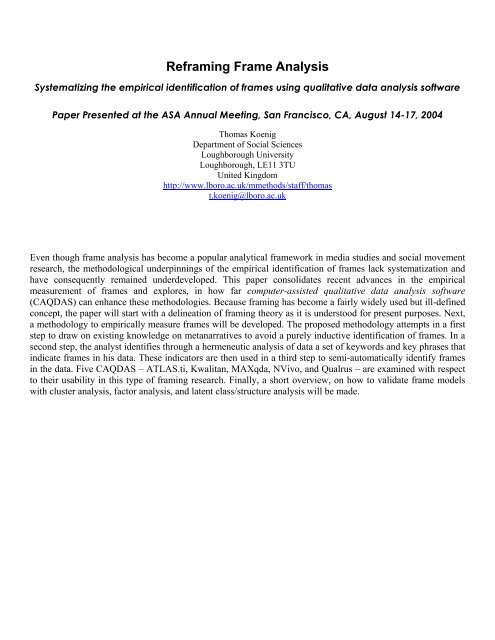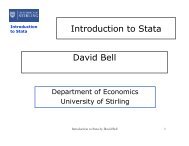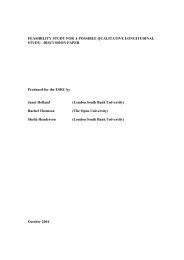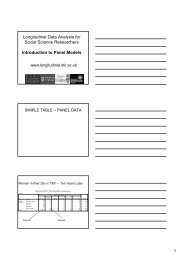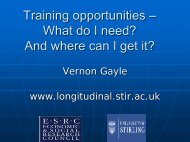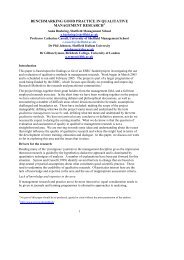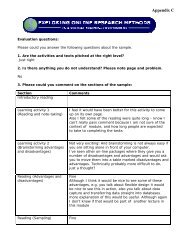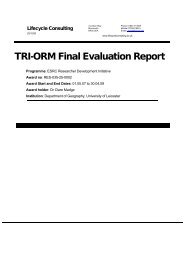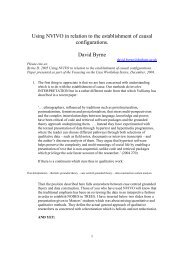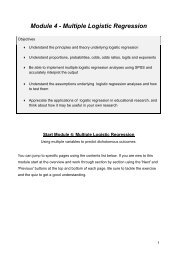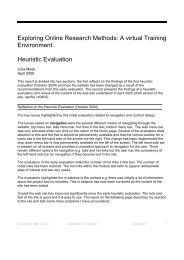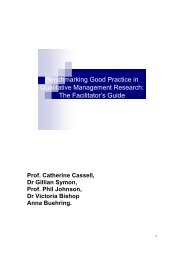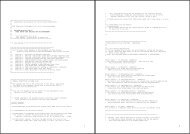Reframing Frame Analysis
Reframing Frame Analysis
Reframing Frame Analysis
Create successful ePaper yourself
Turn your PDF publications into a flip-book with our unique Google optimized e-Paper software.
<strong>Reframing</strong> <strong>Frame</strong> <strong>Analysis</strong><br />
Systematizing the empirical identification of frames using qualitative data analysis software<br />
Paper Presented at the ASA Annual Meeting, San Francisco, CA, August 14-17, 2004<br />
Thomas Koenig<br />
Department of Social Sciences<br />
Loughborough University<br />
Loughborough, LE11 3TU<br />
United Kingdom<br />
http://www.lboro.ac.uk/mmethods/staff/thomas<br />
t.koenig@lboro.ac.uk<br />
Even though frame analysis has become a popular analytical framework in media studies and social movement<br />
research, the methodological underpinnings of the empirical identification of frames lack systematization and<br />
have consequently remained underdeveloped. This paper consolidates recent advances in the empirical<br />
measurement of frames and explores, in how far computer-assisted qualitative data analysis software<br />
(CAQDAS) can enhance these methodologies. Because framing has become a fairly widely used but ill-defined<br />
concept, the paper will start with a delineation of framing theory as it is understood for present purposes. Next,<br />
a methodology to empirically measure frames will be developed. The proposed methodology attempts in a first<br />
step to draw on existing knowledge on metanarratives to avoid a purely inductive identification of frames. In a<br />
second step, the analyst identifies through a hermeneutic analysis of data a set of keywords and key phrases that<br />
indicate frames in his data. These indicators are then used in a third step to semi-automatically identify frames<br />
in the data. Five CAQDAS – ATLAS.ti, Kwalitan, MAXqda, NVivo, and Qualrus – are examined with respect<br />
to their usability in this type of framing research. Finally, a short overview, on how to validate frame models<br />
with cluster analysis, factor analysis, and latent class/structure analysis will be made.
Framing Theory<br />
<strong>Frame</strong> analysis is en vogue (Meyer 1999: 85; Reese 2001: 7; Benford and Snow 2000: 611f), although it was initially<br />
predicted to become a niche method at best. One Contemporary Sociology reviewer complained that <strong>Frame</strong> <strong>Analysis</strong> is<br />
cumbersome to read (Davis 1975: 603), the other one wondered, if an adequate systematization of frame analysis would be<br />
feasible (Gamson 1975: 605).<br />
Probably the single most important factor for the success of Goffman's frame analysis is therefore its unorthodox<br />
application. <strong>Frame</strong> analysis is no longer Goffman's frame analysis, but is frequently only loosely connected to the original<br />
formulation. Notwithstanding the recurrent symbolic nods to Goffman, today's "frame analysis" spans a number of<br />
disparate approaches (D'Angelo 2002; Fisher 1997; Maher 2001: 81f; Scheufele 1999: 103, 118), some of which are even<br />
incompatible with each other (Scheufele 1999: 118), While not excluding the possibility of fruitful interaction between the<br />
heterogeneous frame analyses (D'Angelo 2002: 883), conceptual parsimony necessitates the clarification of the framing<br />
concept for present purposes.<br />
This is not the place to overview the wide range of approaches that have been subsumed under the heading of frame<br />
analysis, a task that others (Benford and Snow 2000; D'Angelo 2002; Scheufele 1999) have already accomplished. Instead,<br />
I would like to merge at this juncture certain brands of framing approaches to a more specific theoretical framework. In his<br />
initial and widely quoted definition, Goffman characterized frames as follows:<br />
“I assume that definitions of a situation are built up in accordance with principals of organization which govern<br />
events […] and our subjective involvement in them; frame is the word I use to refer to such of these basic<br />
elements as I am able to identify” (Goffman1974: 10f)In other words, frames are basic cognitive structures which<br />
guide the perception and representation of reality. On the whole, frames are not consciously manufactured but are<br />
unconsciously adopted in the course of communicative processes. On a very banal level, frames structure, which parts of<br />
reality become noticed.<br />
Todd Gitlin has summarized these frame elements most eloquently in his widely quoted (e.g., Miller 1997: 367; Miller<br />
and Riechert 2001b: 115) elaboration of the frame concept:<br />
"<strong>Frame</strong>s are principles of selection, emphasis and presentation composed of little tacit theories about what exists,<br />
what happens, and what matters." (Gitlin1980: 6)<br />
1
2<br />
While it is hard to improve theoretically on this definition, the trouble starts, when it comes to the identification and<br />
measurement of frames. Precisely because frames consist of tacit rather than overt conjectures, notorious difficulties to<br />
empirically identify frames arise (Maher 2001: 84).<br />
The difficulty of measuring latent frames could partially explain the gradual theoretical shift towards a<br />
conceptualization of frames as being more actively adopted and manufactured. Particularly in media studies, it has become<br />
commonplace to treat the choice of frames as a more or less deliberate process. Entman's famous definition of frames led<br />
the way. For Entman,<br />
“[t]o frame is to select some aspects of a perceived reality and make them more salient in a communicating text,<br />
in such a way as to promote a particular problem definition, causal interpretation, moral evaluation, and/or<br />
treatment recommendation.” (Entman 1993: 52)Notice the shift towards active selection of frames, a conception<br />
that has become dominant in media studies. While indeed not agreeing with Entman on much else, D'Angelo (2002: 873)<br />
likewise treats frames as consciously pitched powerful discursive cues. Tankard (2001: 97) moves even beyond the mere<br />
conscious selection of frames, suggesting that journalists at times circulate frames to deceive their audiences. Reese (2001:<br />
7) goes furthest in the direction of conscious framing suggesting that framing always implies an active process.<br />
Consequently, he demands that the analysts "should ask how much 'framing' is going on" (ibid., 13). In a Goffmanian<br />
framework, such a question would have been non-sensical, since framing is an innate property of all social processes, not<br />
only those most consciously manufactured. This paper sticks more to the original approach and thus treats frames as<br />
"conceptual scaffolding" (Snow and Benford 1988: 213).<br />
<strong>Frame</strong> Typology<br />
Since framing became a popular approach in the late 1980s, an extensive and disparate laundry list of frames has emerged<br />
in the literature (Benford 1997: 414). This disparity of frames leaves one wonder, whether anything can be framed as a<br />
frame. Unfortunately, many studies leave the reader in the dark about the actual process of empirical frame detection. Even<br />
otherwise exceptionally well argued studies laconically describe the frame identification process in a footnote with<br />
"[f]rames were analyzed from the actual language of the reported claim (direct and reported speech)" (Statham and Mynott<br />
2002: 10, Fn. 6). In some cases, at least the measurement model for frames is clarified. In these cases the reader is<br />
presented with a list of more or less parsimoniously identifiable frame terms, "attributes" or "devices," which were used as<br />
manifest indicators for the identification of frames (e.g., Ferree et al.2002; Koella [ 2003] 2003; Semetko and Valkenburg<br />
2000; Semetko and Valkenburg 2000; Ullrich 1998). By making their entire coding scheme online available, Ferree et al.
3<br />
(2002) are in this respect the trailblazers for a new kind of transparency that has been made possible by the new digital<br />
technologies. 1 While increased transparency and accountability certainly render framing research more credible, they still<br />
do not solve the problem of the missing systemization of frame construction. We thus remain heavily so dependent on the<br />
creativity of individual scholars (Maher 2001: 84), that it has been alleged that frames are merely constructed through<br />
"researcher fiat" (Tankard et al. 1991: 5; Tankard 2001: 98).<br />
To counter these objections, the frame identification process should be made more visible and systematic. A first step<br />
towards the latter direction is the construction of a frame taxonomy, distinguishing structural schemes from frames that<br />
focus more on content (Benford 1997: 413).<br />
Within the list of content frames, we can further distinguish between so-called "master frames" or "metanarratives" that<br />
(1) are so pervasive that they can be used in almost any situation, and<br />
(2) posses a superior credibility, in that it has moved beyond empirical scrutiny.<br />
Three master frames surface repeatedly in the literature, i.e. the ethno-nationalist frame (Billig1995; Brubaker and Laitin<br />
1998: 428; Eder 1995: 4; Eder and Schmidtke 1998; Greenfeld 1999: 39; Statham and Mynott 2002: 13), the liberalindividualist<br />
citizenship frame (Berger1971: 97f; Eder 1995: 4 McAdam 1996: 347; Somers 1995; Statham and Mynott<br />
2002: 13) and the harmony with nature frame (Eder1996: 191; Gamson1992: 136).<br />
With these clarifications and distinctions in hand, I will now propose a fairly systematic approach to identify content<br />
frames in textual data. Since the methodology rests on the selection of keywords and key phrases, it is less suited to<br />
identify structural frames such as the conflict frame, as these frames usually become manifest in the structure, and less in<br />
the wording of a speech.<br />
Identifying <strong>Frame</strong>s in Textual Data<br />
Framing in the sense outlined above is a theoretically demanding concept, but – or, rather, as a result – it has proven<br />
elusive to measure (Maher 2001: 84). Even though on a conceptual level, frames, more often than not, are latent, read: not<br />
spelled out in their entirety, it seems reasonable to assume that parts of frames become manifest in speech. If, say, a<br />
speaker has adopted or keyed an ethno-nationalist frame, i.e., the conception that quasi-primordial culturally fairly<br />
homogenous groups of people can be delineated (and probably should be granted some degree of self rule), we would<br />
expect this speaker to refer some components of that frame in speech. She or he might, for instance speak about peoples,<br />
1<br />
http://www.ssc.wisc.edu/abortionstudy/, accessed: October 6, 2003.
4<br />
might allude to some historical continuities, might refer to specific (ethnic) nations, such as "the Dutch," etc. These speech<br />
figures in turn can be identified by keywords (Entman 1993: 53; Triandafyllidou and Fotiou 1998: 3.7; Miller and Riechert<br />
2001a: 61ff), which can help to empirically identify frames in large corpora of data.<br />
The first task in the empirical investigation of frames thus becomes the detection of these keywords. As keywords are<br />
manifest, this is a much simpler task than the identification of frames themselves. It has even been suggested to generate<br />
these keywords automatically, simply by mapping the most frequently words or strings within the data (Koella [ 2003]<br />
2003: 7; Miller and Riechert 2001a: 70; Miller and Riechert [ 2003] 1994).<br />
While avoiding researcher bias, this methods unfortunately creates three new problems. To begin with, it starts out with<br />
exactly a researcher fiat, that is in deciding by convention on the optimal number of eigenvectors (Miller and Riechert<br />
2001b: 116). This decision might sound more "objective," as a number can be pegged onto, but that number is just as<br />
arbitrary as the decision on frames. Moreover, the procedure is deeply positivist, assuming that concepts should arise<br />
unmediated from the data. But even within a positivist logic, most statistical tests are based on a priori probabilities. By<br />
basing the decision in the choice of keywords on ex post covariances, these tests become meaningless. While this problem<br />
could be circumvented through a split sample, an even more severe problem is that empirically identified keywords clearly<br />
cannot be interpreted as indicator of meaningful frames. Miller & Riechert (1994), for instance, found besides<br />
"environmental," "any," and "major" to be identifiers of the "environmental protection" frame. It seems obvious that these<br />
are no meaningful framing terms. Indeed, Koella (2002: 8), who most closely follows Miller and Riechert, deviates in this<br />
point, wryly noting that "each set of frame terms was reviewed in context." This proceeding, of course, reintroduces<br />
research fiat through the back door.<br />
Frequency counts might thus hint at possible keywords, but in the end an interpretative identification of relevant<br />
keywords seems to be the more appropriate and more common route (Andsager et al. 2001: 129; Tankard 2001: 103;<br />
Tedesco 2001: 2053, more technically centered: Miller 1997: 369). Reading or listening over a reasonable amount of data,<br />
framing researcher should hermeneutically uncover frames and their corresponding keywords. The three master frames<br />
mentioned above could help the interpretation of data in this respect, as these frames are likely to surface in any<br />
communicative processes in modernity.
5<br />
Once keywords have been obtained, they can then be used in conjunction with common CAQDAS and word maps such<br />
as WordNet 2 or Wortschatz 3 to code large amounts of data in a fairly short time. Initially, all keywords should become<br />
lemmatized, that is all their inflections forms are to be found. Next, their listemes, that is those linguistic representations 4<br />
which correspond to the mental lexemes held by persons involved in the communicative practices that are researched,<br />
should be identified. Listemes are the actual conceptual categories in the minds of individuals, regardless of their linguistic<br />
representation. Typically, true synonyms represent different linguistic representations of the same listeme, so for any<br />
keyword synonyms should be retrieved from the relevant thesauri. Linguistic research has shown that the mind orders<br />
listemes in a network structure (Gallmann 1991: 274). It might thus be advisable to also group keywords with their listeme<br />
neighbors. I would term the set of a listeme and its most closely related neighbors a fuzzy listeme. Figure 1 visualizes a<br />
fuzzy listeme for "car", highlighting all associated lemmata in green. If "car" is considered a keyword for a certain frame,<br />
then the fuzzy listeme might include the lemmata of "car", its synonyms "auto", "automobile" (as found in WordNet) and<br />
its significant 5 collocations "Ford,", "GM," "Chrysler," "Honda," "Nissan," "Toyota", "Saturn" as found in Wortschatz. 6<br />
The question, if it is prudent to include these brand names in a fuzzy listeme for research purposes will depend on the<br />
context of your data.<br />
Both word maps also tell you that "car" has "cable" as a significant left neighbor. A "cable car" hardly belongs to the<br />
same fuzzy listeme as "car." Likewise, in later keyword searchers homonyms might pose a problem (Bolden and<br />
Moscarola 2000: 453; Miller 1997: 369; Miller and Riechert 2001a: 65). In the current example, if "Saturn" is chosen to be<br />
included in the fuzzy listeme, the homonym planet "Saturn" would be required to be eliminated from analysis.<br />
2<br />
http://www.cogsci.princeton.edu/~wn/, accessed: November 27, 2003.<br />
3<br />
http://wortschatz.uni-leipzig.de/, accessed: November 27, 2003; for a selection of more electronic word maps, cf.<br />
http://www.lboro.ac.uk/research/mmethods/resources/analysis/linguistic.html, accessed: December 7, 2003.<br />
4<br />
In written text, these are words, but audio and video data they also refer to visual and audial discursive cues.<br />
5<br />
Universal frequency and collocation data are still not available in desirable quality (Quasthoff and Wolf [ 2003] 2003: 1), but<br />
Wortschatz currently is the most reliable database in this respect.<br />
6<br />
It is apparent that the corpus of Wortschatz contains an US-American bias.
6<br />
Figure 1 Fuzzy Listeme "Car"<br />
Framing and CAQDAS<br />
The approach to identify a fuzzy listeme through keywords sounds, as if it would be ideally suited to CAQDAS with its<br />
GREP search and coding functions. Initially, hermeneutic coding of frames might detect relevant lexeme. Codes could then<br />
be automatically generated through searching by for the strings that identify lemmata. The instances, in which keywords<br />
take on a to be excluded specific meaning, such as "cable car" in above example could be excluded through Boolean search
7<br />
operations. Homonyms could by eliminated from analysis by visually inspecting the textual environment of the keywords<br />
in question and an according interpretative decision on the meaning of the homonym in question. These seem sufficiently<br />
circumscribed procedures to be performed by a computer algorithm with the odd human input decision. Alas, the grounded<br />
theory bias of CAQDAS (Carvajal [ 2003] 2002: 3; Coffey et al. [ 2003] 1996: 7.3; Lonkila 1995; Welsh 2002: 3) quickly<br />
showed and in the end only with a great deal of persistence and software tinkering it was feasible to obtain the desired<br />
analysis. 7<br />
To assess the usability of CAQDAS for the methodology proposed here, we collected postings from an internet forum.<br />
The forum in question is hosted by the website of the Christian Democratic Union (CDU), the main conservative party in<br />
Germany. We downloaded the forum thread, in which CDU supporters debated the legitimacy of the dismissal of a CDU<br />
MP from the parliamentary ranks of the party. 8 The dismissal had been triggered by a speech by the MP, which contained<br />
elements that were widely regarded as anti-Semitic. Many rank and file members considered the dismissal unjustified and<br />
hence a lively debate ensued in the forum.<br />
Importing the Files<br />
As with almost all internet data, postings from the forum came in HTML format. In this particular case, we obtained a<br />
single HTML page incorporating altogether 2626 postings. We split this page using the csplit 9 program into 2626 separate<br />
files. Since none of the five CAQDAS we examined can actually directly process HTML, the files were stripped of their<br />
HTML tags using NoteTab. As a result we obtained 2626 plain text files, with each file representing one posting. Of the<br />
five programs, MAXqda is the only software unable to process plain text files, requiring instead rich text format. We used<br />
ABC Amber Text Converter 10 to batch convert all plain text into rich text format for usage in MAXqda. While the<br />
conversion to plain text required only seconds, a Pentium 4 computer with 512MB RAM required more than three hours to<br />
convert to RTF.<br />
7<br />
By name, CAQDAS are designed for a wide variety of qualitative approaches, in practice many developers and users say<br />
"qualitative methodology" and think "Grounded Theory." Admittedly, there is neither a strict adherence among those who claim<br />
allegiance to Grounded Theory (Glaser and Strauss1967; Glaser [ 2003] 2002; Strauss and Corbin1990) to the procedures suggested by<br />
Glaser and Strauss (Bong [ 2003] 2002: 3f Lee and Fielding [ 2003] 1996: 3.1), nor is Grounded Theory an unequivocal paradigm in<br />
itself (Strübing 2002). But to jump from that observation to the conclusion that the centrality of Grounded Theory for CAQDAS is a<br />
myth (Gibbs et al. [ 2003] 2002: 6; Bong [ 2003] 2002: 6), creates itself a myth (MacMillan and Koenig 2004).<br />
8<br />
http://www.cdu.de/cgi-bin/forum.cgi?zeigealle=/forum/thema4/ilelEtrLM.ovr, accessed: December 10, 2003.<br />
9<br />
http://sourceforge.net/project/shownotes.php?release_id=151105, accessed: December 1, 2003.<br />
10 http://www.thebeatlesforever.com/processtext/, accessed: November 30, 2003.
8<br />
Free Coding<br />
Once all documents had been imported, simple hermeneutical keyword coding was performed. With the three master<br />
frames in mind, and an initial skimming of the documents, we started highlighting and coding those sections of the<br />
documents, which we deemed indicative for the frames we saw emerging from the discourse. As inductive coding is<br />
standard praxis in Grounded Theory, this type of coding unsurprisingly worked well in most programs. Still, we found<br />
some quibbles in the process.<br />
Kwalitan offers an intuitive coding through highlighting keywords or phrases and a pop-up menu on right-click, which,<br />
unfortunately does not automatically show all available codes. Unlike in the other programs, codes can not be order<br />
hierarchically. They are also not shown when working on a document, which hinders the coding process considerably, as<br />
double or even triple codings likely occur.<br />
NVivo permits quick coding of keywords with two mouse clicks; codes can be created at will and are neatly organized in a<br />
handy code menu. Unlike Kwalitan, NVivo offers a margin in the document window, where code stripes can be displayed.<br />
Alas, the display of the code stripes brings our computer to a standstill, a shortcoming is well known to the developers. 11<br />
MAXqda does not share NVivo's and Kwalitan's blind coding problems, but free coding is slightly slower than in other<br />
programs, because a code needs to be first created in the – still Windows 3.11 style – Codes Window and only then can be<br />
used for coding. Even though all codes are conveniently organized in the Codes Window, the drop down menu for codings<br />
is disorganized, which makes it at times difficult to find the desired code. There is a little bug in the coding procedure, as at<br />
times not all codes are available for coding. Double clicking the desired code in the coding window, solves this problem.<br />
Finally, Qualrus and ATLAS.ti allow for the most intuitive and comfortable free coding procedures. Both open a well<br />
organized coding window after right-clicking a highlighted portion of the text and there display of codes in the document<br />
margins is impeccable. Qualrus offers additional help in suggestion codes based on correlations between existing codes<br />
(Brent and Slusarz 2003: 189), a procedure that is irrelevant for present purposes, though. 12 ATLAS.ti offers additional<br />
"quick" and "in vivo" coding procedures, which allowed for the most rapid coding of all programs in question.<br />
11 http://www.qsrinternational.com/support/faq/FAQ/answer.asp?ID=137, accessed: December 9, 2003.<br />
12 It is in our view, hard to tell, if the suggestion algorithm, which is based on a positivist-inductive logic, would not be of more harm<br />
than help in most cases.
9<br />
Altogether, free coding was easy enough in all five programs, with the missing coding views in Kwalitan and NVivo<br />
being the biggest, but still minor annoyances. From the reading, we distilled five hypothesized frames based on two master<br />
frames, whose corresponding lemmata are displayed in Table 1.<br />
Automatic Coding<br />
Four types of searches were to be performed. Unanimous lemmata such as "Gutmensch" ("do-gooders") require only<br />
simple string searches. Lemmata such as "Freiheit" ("freedom") are fairly unanimous, but acquire in specific contexts a<br />
different meaning. For instance, "Freiheit" could also be part of the newspaper title Junge Freiheit, a neo-right propaganda<br />
paper, in which case it would no longer belong to the lexeme "freedom." Boolean searches could automatically eliminate<br />
such double meanings. Then there are lemmata that only become the desired frame indicator, if they refer to specific<br />
lemmata. For instance, one hypothesized frame in the debate evoked a "normalization" of German ethnicity, claiming a<br />
Sonderweg in Germanness because of the atrocities during the Third Reich. In this frame, a calls for, or – in case of its<br />
"countertheme" (Gamson1992: 135) – against, a normalization Germans' relationship to "their ethnicity." Two lexeme,<br />
"normal" and "pride", seemed to be related to this frame, but only if they referred to Germanness. Therefore, they were<br />
only coded in the normalization frame, if they were found close to the "German" lexeme. For this procedure, proximity<br />
searches were needed. Finally, there are searches that require the interpretative input of the coder, as their multiple<br />
meanings cannot be distinguished automatically. For instance, "Spiegel" could refer among others to the popular<br />
newsmagazine Der Spiegel, to the head of the main German Jewish association, Paul Spiegel, or could simply mean<br />
"mirror." These searches do not lend themselves to automatic coding, but require a case by case interpretation by the<br />
researcher.
10<br />
Master <strong>Frame</strong> <strong>Frame</strong> Fuzzy Lexemes Lemmata Exclusions<br />
Liberal<br />
Individualist<br />
Citizenship<br />
Rights<br />
Ethno-<br />
Nationalism<br />
freedom of<br />
speech<br />
rebuke of<br />
elitism<br />
undue Jewish<br />
influence<br />
freedom of speech<br />
repression of<br />
censorship<br />
taboo<br />
Constitution<br />
(Basic Law)<br />
Political Correctness<br />
second chance<br />
witchhunt<br />
metaphor "to keep<br />
cooking"<br />
Basis<br />
Christian Democrat<br />
leadership<br />
Media<br />
Social Sciences<br />
Zentralrat der Juden<br />
American Jews<br />
"Holocaust Industry"<br />
Andersdenkende, -n<br />
Freiheit<br />
Freiheiten<br />
Meinung, -en<br />
Meinungsfreiheit, -en<br />
Meinungsäußerung, -en<br />
Meinungsäusserung, -en<br />
repressiv, -e, -en, -er<br />
Repressivität<br />
unterdrücken, -t, -te, -ten<br />
Unterdrückung<br />
Maulkorb<br />
mündig<br />
Sanktionen<br />
Zensur<br />
Zensor, -en, -s<br />
zensiert, -e, -er, -en<br />
zensieren<br />
Tabu, -isierung, isierungen<br />
tabuisieren, -iert, -ierte<br />
Grundgesetz<br />
Grundrecht<br />
Grundrechte<br />
Verfassung<br />
Artikel<br />
political correctness<br />
political correct<br />
politically correct<br />
PC*<br />
politische Korrektheit<br />
politisch korrekt, -e, -er<br />
Berufsbetroffene, -r, -m, -n<br />
berufsbetroffen<br />
Gutmensch, -en<br />
2. Chance<br />
2.Chance<br />
zweite Chance<br />
2 Chancen<br />
zwei Chancen<br />
Hetzen<br />
Hetzerei, -en<br />
hetzerisch, -e, -er, -en<br />
Hatz<br />
Kochen<br />
kocht<br />
hochkochen<br />
Basis<br />
Parteibasis<br />
CDU-Führung<br />
Partei-Führung<br />
Parteiführung<br />
Merkel, -s<br />
Bosbach, -s<br />
Stoiber, -s<br />
Koch, -s<br />
Medien<br />
Presse<br />
Spiegel<br />
Stern<br />
Journalist, -en<br />
Soziologie<br />
Soziologen<br />
Benz<br />
Zentralrat<br />
ZdJ<br />
Friedman, -s<br />
Spiegel, -s<br />
amerikanische Jüdin<br />
Holocaust-Industrie<br />
Holocaustindustrie<br />
Finkelstein, -s<br />
Junge Freiheit<br />
Mercedes-Benz<br />
Daimler-Benz<br />
Der Spiegel<br />
Im Spiegel<br />
Spiegel Artikel
11<br />
normalization of<br />
German<br />
ethnicity<br />
Anti-Semitism<br />
Germanness<br />
patriotism<br />
collective guilt<br />
German<br />
guilt<br />
nation of perpetrators<br />
normal<br />
pride<br />
anti-Semitism<br />
Jews/Jewish/Jewry<br />
religion<br />
Nazis<br />
Deutschland<br />
deutsch, -e, -er, -es, -en<br />
Deutsche, -er, -es, -en<br />
andere Länder<br />
anderen Ländern<br />
Patriot, -en<br />
Patriotismus<br />
patriotisch, -er, -em, -en<br />
Kollektivschuld<br />
kollektiv schuld, -ig<br />
Deutschland<br />
deutsch, -e, -er, -es, -en<br />
Deutsche, -er, -es, -en<br />
Schuld<br />
schuldig, -e, -er, -en<br />
Schuldige, -er, -en<br />
Tätervolk, -völker<br />
normal, -e, -er<br />
Normales<br />
Normalisierung<br />
stolz, -e, -er<br />
Stolz, -es<br />
Nationalstolz, -es<br />
Antisemit<br />
Anti-Semit<br />
Antisemit, -en<br />
Anti-Semiten<br />
Möllemann, -s<br />
Karsli, -s<br />
Walser, -s<br />
Jenninger, -s<br />
Jude, -n<br />
jüdisch, -e, -er<br />
Religion<br />
braun<br />
Nazi, -s<br />
NSDAP<br />
Nationalsozialist, -en<br />
nationalsozialistische, -r ,-n, -m<br />
Table 1 Framing Devices (search terms set in boldface, homonyms in orange, conditional searches in olive)<br />
Ideally, simple, Boolean, and proximity searches would thus be coded automatically, while those searches that required<br />
user input (highlighted in orange in Table 1) would display the context, in which the word is found to facilitate a swift<br />
identification of the proper code. None of the programs fulfilled all our requirements, but there were substantial differences<br />
in the adequacy of the different programs.<br />
Qualrus appeared to be a prime candidate for our tasks. It is the most recently developed program, and boosts automatic<br />
coding functions. Yet, Qualrus turned out to be the least suited for our purposes. Its search functions are not comprehensive<br />
and efficient, if fairly speedy. Using the Q-Tools search menu in Qualrus, simple string searches were completed within 23<br />
seconds over all documents. When searching across paragraphs, the same search would take more than an hour. Since we<br />
were only interested in instances of frames within documents, the latter problem did not concern us. Boolean search is<br />
implemented, but it is only possible to combine "and" and "or," but not "not" operators. Proximity searches are not<br />
implemented, thus both more sophisticated search strategies we required were not available. Interactive coding turned out
12<br />
to be fairly cumbersome: From the search window a link for each document needs to be followed, after which the search<br />
window disappears, and cannot be retrieved through the familiar options ("ALT-TAB" or "CTRL-TAB" keystrokes or<br />
Windows menu), but only by reopening Q-Tools. In the document window, the search term needed to be found manually.<br />
The most important problem was however that Qualrus does not allow for automatic coding of keywords. It requires first a<br />
manual definition of analytic "segments," which cannot be generated automatically. The program is thus unsuitable for<br />
efficient automatic codings of large document samples.<br />
So is NVivo, but for different reasons. NVivo's search functions, which owe much to earlier NUD*IST releases, no<br />
longer beat the competition "hands down" (Weitzman and Miles1995: 248), but NVivo is still the only program that allows<br />
for fuzzy searches, that is, string searches, in which the finds differ in one or more characters from the search string. That<br />
function is of course of particular importance for Usenet, internet fora, listserv, and chat room research, where users all too<br />
frequently misspell words. In our case, for instance, NVivo found 851 cases of lemmata containing the "antisemit" string,<br />
while all other programs found only 848 instances. Yet, in 29 seconds a simple fuzzy string search was accomplished still 7<br />
times faster than a regular search in ATLAS.ti, the slowest competitor. When interactive coding is required, the procedure<br />
become slightly cumbersome. Keywords cannot be display in their context, it is therefore necessary to open each document<br />
that contains a homonym going through three successive windows. Boolean searches of text strings also require somewhat<br />
lengthy procedures; the strings in question first need to be transformed into codes, which subsequently can be searched<br />
with all Boolean and operators. As in the other CAQDAS, but unlike in the freeware Inforapid Search & Replace, 13 which<br />
we used as a benchmark program, slightly more complex combinations of the type "A AND B AND NOT C" are not<br />
permitted and thus must be run successively. While these limitations might be mere nuisances, it would turn out that any<br />
Boolean or proximity search across more than 900 documents would last more than three hours. As the searching time rises<br />
exponentially with the number of documents (600 documents can be searched in about 12 minutes, 300 documents in 30<br />
seconds), these searches became infeasible. Even though the automatic coding functions were working smoothly, if at<br />
times somewhat serendipitously, NVivo was thus not suitable for our tasks, an assessment that flies in the face of claims<br />
that "unique and innovative developments in QSR software [...] have contributed significantly to […] advances" in<br />
integration of qualitative and quantitative data and methodologies (Bazeley 2002: 230).<br />
13 http://www.inforapid.de/html/searchreplace.htm, cessed: December 11, 2003.
13<br />
ATLAS.ti offers the widest range of autocoding options. It allows for single coded automatically with a wide range of<br />
coding options. Like in NVivo, Boolean and proximity searches, require prior coding of single strings. In the somewhat<br />
opaque search window, all Boolean operators can be combined, even though AND and OR are not available in a single<br />
search. In theory, this is an almost ideal autocoding environment. In practice, each search and coding procedure took<br />
between 6 and 15 minutes for all 2626 files, which meant quite a wait. Unlike NVivo, ATLAS.ti does not tie all system<br />
resources, however, so you can work in other programs in the meantime. However, ATLAS.ti appeared much more<br />
instable than NVivo. Roughly after every other autocoding, the program would crash by simply exiting, resulting in a loss<br />
of all previous work. Interactive searches require both Code Manager and document window to be open, so at times some<br />
juggling of windows is required, but altogether this constitutes the most facile interactive coding of all programs in<br />
question.<br />
MAXqda features the most arcane user interface, clearly still grounded in the Windows 3.11 ergonomics. Its search<br />
functions are not as powerful as those offered by its competitors. Boolean search, for instance, does not allow for the NOT<br />
operator (even though via "logical activation" of text can partially be circumvented), proximity searches can only be<br />
limited to paragraphs, not to word distances as in the other programs. Yet, MAXqda is more suitable for the type of<br />
research proposed here. To begin with, its interface, while being old is quite intuitive. Boolean and proximity searches are<br />
performed in a fraction of the time that ATLAS.ti or NVivo require and interactive coding is as simple – or difficult, as<br />
MAXqda also does not allow for showing keywords in context – as in ATLAS.ti, while the program is much more stable.<br />
While MAXqda may have shortcomings for other methodologies, we were able to code above coding scheme within four<br />
hours, while in ATLAS.ti we needed a full working day to code only the first fuzzy lexeme 14 and in NVivo and Qualrus we<br />
were not able to accomplish our work at all. It might there fore be no accident that MAXqda's predecessor winMAX was<br />
the only CAQDAS we know of that has been used for framing analysis (Van de Steeg 2003).<br />
Unfortunately, we only evaluated the demonstration version of Kwalitan, which is restricted to four documents at a<br />
time. Therefore we cannot tell, how stable and fast the full version would have been. Its search function is somewhat<br />
counterintuitive, as Boolean searches can only be made using the Filter window, in which on top a few translations from<br />
the original Dutch are missing. Unlike all other CAQDAS is allows for complex combinations of Boolean searches.<br />
14 Partially, this slowness was due to us losing work because of program crashes.
14<br />
Proximity searches are limited to segments, i.e., paragraphs. Interactive coding is somewhat tedious, because of the lack of<br />
coding stripes. In summary, Kwalitan seems very well suited for our tasks.<br />
Export of Data Matrices<br />
The export of the coding matrices for work in statistical packages or spreadsheets was unproblematic in all programs. Most<br />
programs allow for both export of ASCII text and drag and drop into windows programs. The only minor problem arose<br />
with MAXqda, whose code names mirror the code position within the coding tree, including a backslash separator to<br />
separate tree levels. These names cannot be processed by several programs, notably SPSS and lem, and therefore must be<br />
shortened in a text editor.
15<br />
Task ATLAS.ti Kwalitan MAXqda NVivo Qualrus Inforapid<br />
$395<br />
$370 $445 $399<br />
academic<br />
€390 €315 €340<br />
freeware<br />
license<br />
£250<br />
£255 £270<br />
use of system<br />
moderate low low very high low low<br />
resources<br />
file format<br />
rich text<br />
plain text plain text<br />
plain text plain text HTML<br />
required<br />
format<br />
ABC Amber<br />
batch several several<br />
several several<br />
Text<br />
converter freeware freeware<br />
freeware freeware not required<br />
Converter<br />
from HTML options options<br />
options options<br />
(US $24.95)<br />
conversion<br />
16<br />
Table 2 summarizes the results of our attempt to use CAQDAS for the analysis technique proposed here. All programs<br />
contain strength and weaknesses. Qualrus excels in interactive coding, but lacks an automatic coding function. NVivo<br />
offers the widest variety of searches, but limits analysis to a couple of hundreds of documents. ATLAS.ti is the most<br />
versatile program, but its instability and time consumption pose serious problems. MAXqda is easy to use, much more<br />
stable than the previous three programs, but contains some limitations in input, output, and search versatility. Kwalitan has<br />
similar limitations to MAXqda, but it is more versatile in the import and export of files. Unfortunately, since we only tested<br />
its demonstration version, an assessment of its speed and stability cannot be made.<br />
In the end, two of the five examined CAQDAS cannot be recommended for use with the methodology proposed here.<br />
Since Qualrus does not allow for automatic coding, it cannot be used in an efficient way, and must be dismissed as a<br />
candidate, particularly as the freeware InfoRapid would be an efficient helper in coding, if one were to code everything by<br />
hand. The two most popular CAQDAS, NVivo and ATLAS.ti were in principle suited for the analysis, but the fact that<br />
they become instable when used with larger amounts of files is a serious impediment for their use. In fact, NVivo is<br />
inherently incapable of handling more than 700 documents and must therefore be excluded from consideration. ATLAS.ti,<br />
is somewhat more erratically instable. At times the program works fine, performing ten to twenty autocodings without a<br />
problem. Then, there are instances, where a single autocoding is sufficient to crash the program. As we tested Release<br />
Candidate 2, these problems might disappear with the maturing of the program. What will not disappear, is the long time<br />
the program requires for each coding procedure. Each autosave operation and most searches took several minutes. That<br />
may not sound much, but the coding we performed within one working day with ATLAS.ti, took 20 minutes in MAXqda.<br />
ATLAS.ti can therefore only be recommended with some reservations. Particularly, for multi method approaches that<br />
involve data other than simple texts, ATLAS.ti's versatility with multimedia data might nevertheless make it a viable<br />
choice. That leaves us with MAXqda and the dark horse Kwalitan, both of which can be recommended with some<br />
reservations. They are fairly intuitive to use (which sets them apart from the rather idiosyncratic interface of NVivo and the<br />
shrouded terminology of ATLAS.ti) and do the job fairly efficiently. Of the two, Kwalitan seems the more versatile, but as<br />
we only evaluated the demonstration version, it is hard to tell, if a full analysis would have revealed some problems not<br />
anticipated here. The fact that the two lesser known programs turned out to be more suitable for the methodology proposed<br />
here in any case dispels the myth that "the most successful qualitative software packages are likely to be constructed in<br />
ways that meet a range of methodological approaches" (Jackson 2003: 100).
17<br />
Validating <strong>Frame</strong>s<br />
With the quantitative codings in hand, we can tests the empirical adequacy of frame models. Basically, three statistical<br />
techniques have been suggested to measure adequacy of frames quantitatively, namely cluster analysis, factor analysis, and<br />
latent class analysis.<br />
Currently, hierarchical cluster analysis seems to be the most popular method for statistical validation of frames. That is,<br />
if you can speak of "popular", when merely a handful of references exist (Dyer 1994; Koella [ 2003] 2003; Miller 1997;<br />
Miller and Riechert [ 2003] 1994; Miller and Riechert 2001b; Miller and Riechert 2001a). The reason for its relative<br />
popularity is probably the existence of a computer program – VBPro 16 – that is specifically written for this type of analysis.<br />
The reason for its relative unpopularity might be the very same program, that is its command line DOS interface. There are<br />
a few other problems with this methodology, though. To begin with, it requires specific chunks of data – documents with<br />
around 1,000 words –to perform best (Miller 1997: 369). While this problem could be alleviated by slicing or aggregating<br />
data appropriately, the a general problem of all cluster analyses – be it k-means or hierarchical – cannot be circumvented,<br />
namely that it does not offer any real goodness of fit tests (Aldenderfer and Blashfield1984), which in turn makes it<br />
impossible to choose an optimum number of clusters on an empirical basis (Miller and Riechert 2001b: 116; Trochim and<br />
Hover 2003). That means that any number of frames could be posited throughout the texts, without any possibility to<br />
falsify any frame model, which, once again would return us to researcher fiat. On top, hierarchical cluster analysis assumes<br />
texts to belong to either one or the other frame. But it is entirely reasonable, and even likely, that speakers use any number<br />
of frames in a given text. In fact, many speakers actively engage in frame alignment processes such as frame bridging<br />
(Snow et al. 1986), which presuppose the existence of more than one frame in a text. Moreover, cluster analysis assumes a<br />
direct measuring model, but as has been discussed in the theoretical part of this paper, keywords are only indicators of<br />
latent frames. Altogether, hierarchical cluster analysis, thus, seems only ill suited for frame model validations.<br />
Factor <strong>Analysis</strong> seems to avoid all the shortcomings of cluster analysis. It knows well-established goodness of fit<br />
criteria, it assumes a measurement model that does justice to the latency of frames, and it can decide on an empirical basis,<br />
which frame model is more adequate. Yet, to date we know only of one nascent attempt to use frame analysis in framing<br />
studies (Risse and Van de Steeg 2003). Interestingly enough, this appears to be the only frame analytic study, in which<br />
16 http://mmmiller.com/vbpro/vbpro.html, accessed: December 15, 2003.
18<br />
CAQDAS were used (ibid, p.5). While the headway made compared to cluster analysis is considerable, it seems puzzling<br />
that the authors do not even discuss the violation of the scale level assumptions of factor analysis, even though it has been<br />
shown that this violation can seriously affect the substantial results (Magidson and Vermunt 2004).<br />
In contrast, latent class analysis exhibits all required features factor analysis offers, but at the same time does not<br />
contain the same shortcomings. It should seem therefore straightforward to introduce it into frame analysis studies.<br />
Although the methodological principles of latent class analysis have been already developed in the fifties (Lazarsfeld 1950;<br />
Hagenaars1993: 20), it has remained an esoteric statistical method for many social scientists (Reunanen and<br />
Suikkanen1999: 3). Until the early eighties, the absence of quantitative studies using latent class analysis could be<br />
explained by the frequently cumbersome estimation of latent class models. Since then, powerful computational equipment<br />
that easily performs these estimations has become widely available. The current draught in studies using this methodology<br />
seems instead to be rooted in the fact that none of the major statistical software packages (SPSS, SAS, and STATA) so far<br />
include procedures for latent class analysis. Freely available stand-alone programs, such as LCAG and lEM, on the other<br />
hand have probably garnished little interest because of their user-interface is not very intuitive.<br />
Basically, latent class analysis can be considered the equivalent of factor analysis for ordinally and nominally scaled<br />
variables (McCutcheon1987: 7). It examines, if a set of observable indicators can meaningfully be projected onto a smaller<br />
set of latent, that is, unobservable classes. Most important theoretical concepts, among them frames, do not translate<br />
straightforwardly into easily empirically observable, that is: measurable, indicators. Latent class analysis that expressly<br />
works with latent, read: unobservable, variables (Lazarsfeld 1950: 363) is therefore in the analysis of frames superior to<br />
other log-linear models that operate exclusively with observable data. In comparison to cluster analysis, latent class<br />
analysis delivers more unequivocal results, as it allows for a number of well-developed goodness of fit measures. And<br />
while it shares with factor analysis the virtue of operating with latent variables, it does not contain the caveat of requiring<br />
hard to come by interval scaled data.<br />
References<br />
Aldenderfer, Mark S and Roger K Blashfield. 1984. Cluster analysis. Beverly Hills, CA: Sage.<br />
Andsager, Julie L., Erica Weintraub Austin, and Bruce E. Pinkleton. Questioning the Value of Realism: Young Adults'<br />
Processing of Messages in Alcohol-Related Public Service Announcements and Advertising. Journal of<br />
Communication 51[1], 121-42. 2001.
19<br />
Bazeley, Pat. 2002. "The evolution of a project involving an integrated analysis of structured qualitative and quantitative<br />
data: from N3 to NVivo." International Journal of Social Research Methodology 5 (3 ): 229-43.<br />
Benford, Robert D. 1997. " An Insider’s Critique of the Social Movement Framing Perspective." Sociological Inquiry 67:<br />
409-30.<br />
Benford, Robert D. and David A. Snow. 2000. "Framing Processes and Social Movements: An Overview and<br />
Assessment." Annual Review of Sociology 26: 11-39.<br />
Berger, Bennett. 1971. Looking for America: Essay on Youth, Suburbia, and Other American Obsessions. Englewood<br />
Cliffs, NJ: Prentice Hall.<br />
Billig, Michael. 1995. Banal Nationalism. London, U.K., Thousand Oaks, CA & New Delhi, India: Sage.<br />
Bolden, Richard and Jean Moscarola. Bridging the Quantitative-Qualitative Divide: the Lexical Approach to Textual Data<br />
<strong>Analysis</strong>. Social science computer review 18[4], 450-60. 2000.<br />
Bong, Sharon A. 2002. "Debunking Myths in Qualitative Data <strong>Analysis</strong>." Forum Qualitative Sozialforschung / Forum:<br />
Qualitative Social Research 3 (2).<br />
Brent, Edward and Pawel Slusarz. 2003. "'Feeling the Beat': Intelligent Coding Advice from Metaknowledge in Qualitative<br />
Research." Social Science Computer Review 21 (3): 281-303.<br />
Brubaker, Rogers and David Laitin. 1998. "Ethnic and Nationalist Violence." Annual Revie of Sociology 24: 423-52.<br />
Carvajal, Diógenes. 2002. "The Artisan's Tools. Critical Issues When Teaching and Learning CAQDAS." Forum<br />
Qualitative Sozialforschung / Forum: Qualitative Social Research 3 (2).<br />
Coffey, Amnda, Beverley Holbrook, and Paul Atkinson. 1996. "Qualitative Data <strong>Analysis</strong>: Technologies and<br />
Representations." Sociological Research Online 1 (1): 4.<br />
D'Angelo, Paul. 2002. "News framing as a multi-paradigmatic research program: A response to Entman." Journal of<br />
Communication 52 (4): 870-88.<br />
Davis, Murray S. 1975. "Review of '<strong>Frame</strong> <strong>Analysis</strong>: An Essay on the Organization of Experience' by Erving Goffman ."<br />
Contemporary Sociology 4 (6): 509-603.<br />
Dyer, Sam C. 1994. "A Newsflow <strong>Analysis</strong> of the Sale of a Public Asset." Australian Journal of Political Science 29: 172-<br />
8.<br />
Eder, Klaus. 1995. The Institutionalization of Environmentalism: Ecological Discourse and the Second Transformation of<br />
the Public Sphere.<br />
Eder, Klaus. 1996. The social construction of nature : a sociology of ecological enlightenment. London ;, Thousand Oaks,<br />
Calif. : Sage Publications.<br />
Eder, Klaus and Oliver Schmidtke. 1998. "Ethnische Mobilisierung und die Logik von Identitätskämpfen." Zeitschrift für<br />
Soziologie 27: 418-37.<br />
Entman, Robert M. 1993. "Framing: Toward Clarification of a Fractured Paradigm." Journal of Communication 43 (4):<br />
51-8.<br />
Ferree, Myra Marx, William Anthony Gamson, Jürgen Gerhards, and Dieter Rucht. 2002. Shaping abortion discourse<br />
democracy and the public sphere in Germany and the United States. Cambridge, New York: Cambridge University<br />
Press.<br />
Fisher, Kim. 1997. "Locating <strong>Frame</strong>s in the Discursive Universe." Sociological Research Online 2 (3).<br />
Gallmann, Peter. 1991. Wort, Lexem und Lemma. In Rechtschreibwörterbücher in der Diskussion: Geschichte – Analyse –<br />
Perspektiven, Ed. Gerhard Augst and Burkhard Schaeder. Frankfurt a/M, FR Germany, Bern, Switzerland, New York,<br />
NY & Paris, France: Peter Lang.<br />
Gamson, William A. 1975. " Review of ‘<strong>Frame</strong> <strong>Analysis</strong>’ by Erving Goffman." Contemporary Sociology 4: 603-7.<br />
Gamson, William A. 1992. Talking Politics. Cambridge, U.K.: Cambridge University Press.
20<br />
Gibbs, Graham R., Susanne Friese, and Wilma C. Mangabeira . 2002. "The Use of New Technology in Qualitative<br />
Research." Forum Qualitative Sozialforschung / Forum: Qualitative Social Research 3 (2).<br />
Gitlin, Todd. 1980. The Whole World Is Watching: Mass Media in the Making and Unmaking of the New Left. Berkeley,<br />
CA, Los Angeles, CA & London, U.K.: University of California Press.<br />
Glaser, Barney. 2002. "Conceptualization: On Theory and Theorizing Using Grounded Theory." International Journal of<br />
Qualitative Methods 1 (2).<br />
Glaser, Barney G and Anselm L Strauss. 1967. The discovery of grounded theory; strategies for qualitative research.<br />
Chicago: Aldine Pub. Co.<br />
Goffman, Erving. 1974. <strong>Frame</strong> <strong>Analysis</strong>: An Essay on the Organization of Experience. New York, NY et al.: Harper &<br />
Row.<br />
Greenfeld, Liah. 1999. Is Nation Unavoidable? Is Nation Unavoidable Today? In Nation and National Identity: The<br />
European Experience in Perspective, Ed. Hanspeter Kriesi, Klaus Armigeon, Hannes Siegrist, and Andreas Wimmer.<br />
Chur, Switzerland & Zürich, Switzerland: Rüegger.<br />
Hagenaars, Jacques A. 1993. Loglinear Models with Latent Variables. Newbury Park, CA & London, U.K.: Sage.<br />
Jackson, Kristi. 2003. "Blending Technology and Methodology: A Shift toward Creative Instruction of Qualitative<br />
Methods with NVivo." Qualitative Research Journal: 96-110.<br />
Koella, Jennifer Campell. The Impact of Interest Groups and New Media Framing on Public Opinion: The Rise and Fall of<br />
the Clinton Health Care Plan. Annual Meeting of the Midwest Association for Public Opinion Research. 2003.<br />
October 21, 2003.<br />
Lazarsfeld, Paul F. 1950 . The Logical and Mathematical Foundations of Latent Structure <strong>Analysis</strong>. In Measurement and<br />
Prediction, Ed. Samuel A Stouffer. Princeton, N.J. : Princeton University Press.<br />
Lee, Raymond M and Nigel Fielding. 1996. "Qualitative Data <strong>Analysis</strong>: Representations of a Technology: A Comment on<br />
Coffey, Holbrook and Atkinson." Sociological Research Online 1 (4).<br />
Lonkila, Markku. 1995. In Computer-aided qualitative data analysis : theory, methods and practice, Ed. Udo Kelle.<br />
London : Sage.<br />
MacMillan, Katie and Thomas Koenig. 2004. "The Wow Factor: Preconceptions and Expectations for Data <strong>Analysis</strong><br />
Software in Qualitative Research." Social Science Computer Review 22 (2).<br />
Magidson, Jay and Jereon K. Vermunt. 2004. Comparing Latent Class Factor <strong>Analysis</strong> with Traditional Factor <strong>Analysis</strong> for<br />
Datamining. In Statistical Data Mining and Knowledge Discovery, Ed. Hampersum Bozdogan. Boca Raton, FL &<br />
London, U.K.: Chapman & Hall/CRC.<br />
Maher, T. Michael. 2001. Framing: An Emerging Paradigm or a Phase of Agenda Setting. In Framing Public Life:<br />
Perspectives on Media and our Understanding of the Social World, Ed. Stephen D Reese, Oscar H Gandy, and August<br />
E Grant. Mahwah, NJ: Lawrence Erlbaum Associates.<br />
McAdam, Doug. 1996. The Framing Function of Movement Tactics: Strategic Dramaturgy in the American Civil Rights<br />
Movement. In Comparative Perspectives on Social Movements: Political Opportunities, Mobilizing Structures and<br />
Cultural Framings, Ed. Doug McAdam, John D. McCarthy, and Mayer N. Zald. Cambridge, U.K.: Cambridge<br />
University Press.<br />
McCutcheon, Alan. 1987. Latent Class <strong>Analysis</strong>. Newbury Park, CA & Beverly Hills, CA: Sage.<br />
Meyer, David S. 1999. "Tending the Vineyard: Cultivating Political Process Research." Sociological Forum 14: 79-92.<br />
Miller, M. Mark. 1997. "<strong>Frame</strong> Mapping and <strong>Analysis</strong> of News Coverage of Contentious Issues." Social Science Computer<br />
Review 15 (4): 367-78.<br />
Miller, M. Mark and Bonnie Parnell Riechert. Identifying Themes via Concept Mapping: A New Method of Content<br />
<strong>Analysis</strong>. Association for Education in Journalism and Mass Communication Annual Meeting. 1994. October 20,<br />
2003.
21<br />
Miller, M. Mark and Bonnie Parnell Riechert. 2001a. <strong>Frame</strong> Mapping: A Quantitative Method for Investigating Issues in<br />
the Public Sphere. In Applications of computer content analysis, Ed. Mark D West. Westport, CT & London, England:<br />
Ablex Pub.<br />
Miller, M. Mark and Bonnie Parnell Riechert. 2001b. The Spiral of Opportunity and <strong>Frame</strong> Resonance: Mapping the Issue<br />
Cycle in News and Public Discourse. In Framing Public Life: Perspectives on Media and our Understanding of the<br />
Social World, Ed. Stephen D Reese, Oscar H Gandy, and August E Grant. Mahwah, NJ: Lawrence Erlbaum<br />
Associates.<br />
Quasthoff, Uwe and Christoan Wolf. Effizientes Dokumentenclustering durch niederfrequente Terme. 2003. Novemeber<br />
30, 2003.<br />
Reese, Stephen D. 2001. Prologue - Framing Public Life: A Bridging Model for Media Research. In Framing Public Life:<br />
Perspectives on Media and our Understanding of the Social World, Ed. Stephen D Reese, Oscar H Gandy, and August<br />
E Grant. Mahwah, NJ: Lawrence Erlbaum Associates.<br />
Reunanen, Esa and Risto Suikkanen. 1999. Latent Class <strong>Analysis</strong>.: Wandering in Latent Space. Konstanz, Germany:<br />
Universität Konstanz.<br />
Risse, Thomas and Marianne Van de Steeg. An Emerging European Public Sphere? Empirical Evidence and Theoretical<br />
Clarifications . Europeanisation of Public Spheres, Political Mobilisation, Public Communication and the European<br />
Union. 2003. Berlin, Germany, Wissenschaftszentrum Berlin.<br />
Scheufele, Dietram A. 1999. "Framing as a Theory of Media Effects." Journal of Communication 49 (4): 103-22.<br />
Semetko, Holli A. and Patti M. Valkenburg. 2000. "Framing European Politics: A Content <strong>Analysis</strong> of Press and<br />
Television News." Journal of Communication 50 (2): 93-109.<br />
Snow, David A. and Robert D. Benford. 1988. "Ideology, <strong>Frame</strong> Resonance and Participant Mobilization." International<br />
Social Movement Research 1: 197-219.<br />
Snow, David A., E. Burke Rochford, Steven K. Worden, and Robert D. Benford. 1986. "<strong>Frame</strong> Alignment Processes,<br />
Micromobilization and Movement Participation." American Sociological Review 51: 464-81.<br />
Somers, Margaret R. 1995. "Narrating and Naturalizing Anglo-American Citizenship Theory: The place of Political<br />
Culture and the Public Sphere." Sociological Theory 13: 229-74.<br />
Statham, Paul and Ed Mynott. The Dilemma of Anti-Racist and Pro-Migrant Mobilisation in Britain: Visibility or Political<br />
Power? 2002.<br />
Strauss, Anselm L and Juliet M Corbin. 1990. Basics of qualitative research : grounded theory procedures and techniques.<br />
Newbury Park, Calif. : Sage Publications.<br />
Strübing, Jörg. 2002. "Just do it? Zum Konzept der Herstellung und Sicherung von Qualität in grounded theory-basierten<br />
Forschungsarbeiten." Kölner Zeitschrift für Soziologie und Sozialpsychologie 54 (2): 318-42.<br />
Tankard, James W., Laura Handerson, Jackie Sillberman, Kriss Bliss, and Salma Ghanem. Media <strong>Frame</strong>s: Approaches to<br />
Conceptualization and Measurement. Association for Education in Journalism and Mass Communication. 1991.<br />
Tankard, James W., Jr. 2001. The Empirical Approach to the Study of Media Framing. In Framing Public Life:<br />
Perspectives on Media and our Understanding of the Social World, Ed. Stephen D Reese, Oscar H Gandy, and August<br />
E Grant. Mahwah, NJ: Lawrence Erlbaum Associates.<br />
Tedesco, John C. Issue and Strategy Agenda-Setting in the 2000 Presidential Primaries. American behavioral scientist<br />
44[12], 2048-67. 2001.<br />
Triandafyllidou, Anna and Anastasios Fotiou. 1998. "Sustainability and Modernity in the European Union: A <strong>Frame</strong><br />
Theory Approach to Policy-Making." Sociological Research Online 3 (1).<br />
Trochim, William and Debra Hover. Mapping Student Views of the Benefits of a Course Website. 2003.<br />
Ullrich, Kerstin. Soziale Bewegung und kollektive Identität: Der Diskurs über Abtreibung und Reproduktionstechnologien<br />
am Beispiel feministischer Identitätskonstruktion. 1998. Florence, Italy, European University Institute.
22<br />
Weitzman, Eben A and Matthew B Miles. 1995. Computer Programs for Qualitative Data <strong>Analysis</strong>: A Software<br />
Sourcebook. Thousand Oaks, Calif. : Sage Publications.<br />
Welsh, Elaine. 2002. "Dealing with Data: Using NVivo in the Qualitative Data <strong>Analysis</strong> Process." Forum Qualitative<br />
Sozialforschung / Forum: Qualitative Social Research 3 (2).


